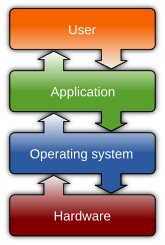Operating systems offer a number of services to application programs and users. Applications access these services through application programming interfaces (APIs) or system calls. By invoking these interfaces, the application can request a service from the operating system, pass parameters, and receive the results of the operation. Users may also interact with the operating system with some kind of software user interface like typing commands by using command line interface (CLI) or using a graphical user interface. For hand-held and desktop computers, the user interface is generally considered part of the operating system. On large multi-user systems like Unix and Unix-like systems, the user interface is generally implemented as an application program that runs outside the operating system.
While servers generally run Unix or some Unix-like operating system, embedded system markets are split amongst several operating systems,[1][2] although the Microsoft Windows line of operating systems has almost 90% of the client PC market.
Operating systems

No comments:
Post a Comment